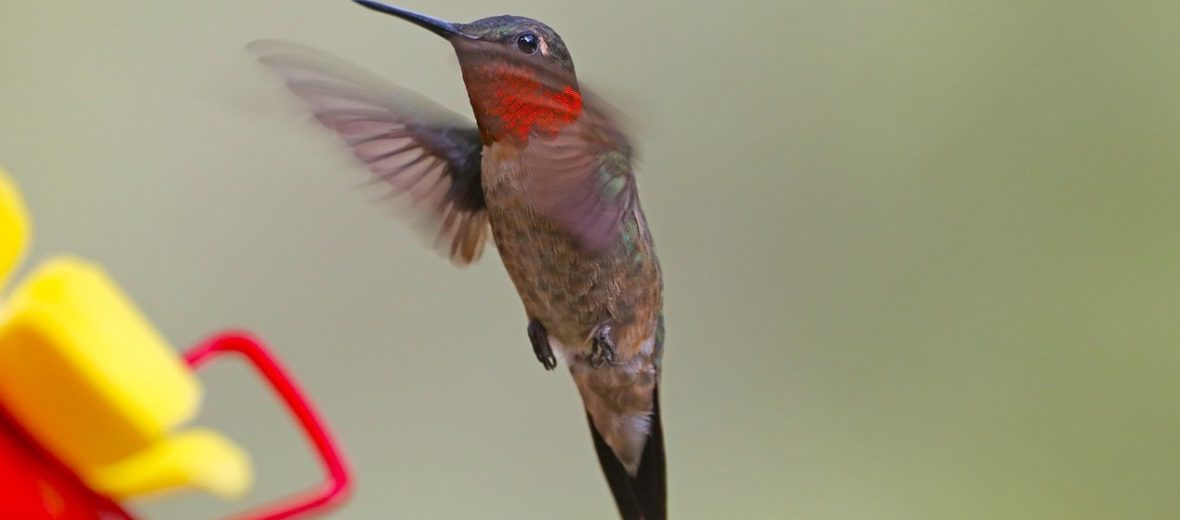
The ruby-throated hummingbird is a common sight in southern Canada and the eastern half of the United States, during the summer months. During the winter, these little birds migrate as far south as Mexico and Central America. With an overall population of around 36,000,000 and increasing, these little critters are listed as Least Concern by the IUCN. Their greatest threats are accidental poisoning (due to pesticide use), and predation by other animals.
First the Stats…
Scientific name: Archilochus colubris
Weight: Up to .11 ounce
Length: Up to 3.5 inches
Wingspan: Up to 4 inches
Lifespan: Up to 5 years
Now on to the Facts!
1.) The Swedish naturalist, Carl Linnaeus, officially described these birds in 1758.
2.) Generally speaking, these hummers are not afraid of humans, and will come rather close to them, while feeding.
3.) There is a myth that these birds will cling to the backs of larger migratory birds, in order to hitch a ride and save strength during migration. Nope. These birds make the trek all on their own.
4.) Males are very territorial and will even try to challenge bees and wasps for available flowers.
5.) Like other hummingbirds, they are attracted to the color red. They have even been known to approach people with red shirts, mistakenly thinking the shirt is a flower.
But wait, there’s more on the ruby-throated hummingbird!
6.) Besides their primary staple food – nectar – these birds will also occasionally dine on smaller insects.
7.) When food is readily available, the ruby-throated hummingbird will skip over other flowering plants to seek out only red flowers.
Did you know…?
They are solitary creatures that only come together to breed and the breeding and courtship only lasts a few minutes.
8.) These hummingbirds are sexually dimorphic, in that males have a the characteristic red gorget (throat patch) and an iridescent green body. Females have a paler green body and lack the throat patch.
9.) Females are very picky about who they mate with and will reject multiple males before deciding on a suitor.
10.) Nests are built by the females and are about the size of a walnut.
But wait, there’s still more on the ruby-throated hummingbird!
11.) Eggs are about the size of a pea.
12.) The female will only lay up to 2 eggs each breeding season. The eggs hatch in up to 12 days.
13.) In just a mere few week’s time, the chicks are ready to leave the nest and start life on their own.
Did you know…?
The female will only tolerate her chicks feeding with her for the first few weeks. Then she will chase them off, just like they were a competitive hummingbird or insect.
14.) Their vocalizations consist of rapid, squeaky chirps. These chirps are primarily used as a warning call to other males, to stay out of their territory.
15.) During courtship, males produce a rapid tik-tik tik-tik tik-tik sound with their wings. They also produce a faint, repeated whining sound from their tail feathers.
But wait, there’s still a little more on the ruby-throated hummingbird!
16.) Flight muscles make up to 30% of their total body weight.
17.) Like other hummers, their wings attach at a shoulder joint. This allows for greater wing rotation during flight and affords them the ability to not only hover, but to fly backwards and even upside down.
18.) Sharp-shinned hawks, merlins, American kestrels, Mississippi kites, domestic cats, loggerhead shrikes, greater roadrunners, bird-eating snakes, some lizards, and even praying mantises all prey on these birds… when they can catch them.
Did you know…?
While hovering, these bird’s wings beat up to 80 times per second!
19.) These little birds can fly up to 30+ mph.
20.) When flying, not hovering, their wing beats measure up to 53 beats per minute.
But wait, there’s still just a little bit more on the ruby-throated hummingbird!
21.) They can dive at speeds of up to 63 mph.
22.) Before they migrate south, these birds will eat up to 2x their body weight in nectar.
Now a Short Ruby-Throated Hummingbird Video!
Be sure to share & comment below! Also, check out the Critter Science YouTube channel. Videos added regularly!

Want to suggest a critter for me to write about? Let me know here.
Some source material acquired from: Wikipedia & IUCN



